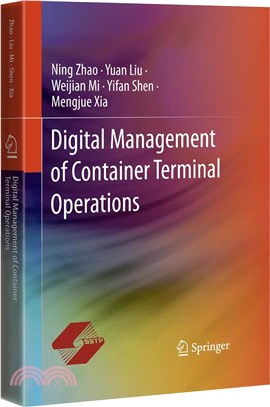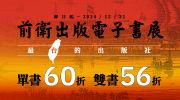人民幣定價:290 元
定價
:NT$ 1740 元優惠價
:87 折 1514 元
絕版無法訂購
商品簡介
作者簡介
名人/編輯推薦
目次
相關商品
商品簡介
本書以數字化管理為主線,系統地分析了集裝箱碼頭各種主營業務中環環相扣的信息流環節以及各環節之間的相互關係,細緻入微地闡述了集裝箱碼頭信息收集與處理、資源計劃與設備調度以及看板管理模式下的現場實際作業等營運與管理過程,提出並分析了集裝箱碼頭卸提集裝等數字化生產過程中的若干動態決策問題。書中揭示了以碼頭為典型代表的實時型離散物流系統的基本性質、主要特點以及構成要素,描繪了未來集裝箱碼頭數字化、智能化、精益化管理的發展趨勢,提出了鮮明的觀點,具有較強理論性和前瞻性。
作者簡介
宓為建,上海海事大學物流工程學院教授、博士生導師、全國優秀教師。現任上海海事大學工會常務副主席、集裝箱供應鏈技術教育部工程研究中心常務副主任、“物流工程與管理”上海市教委重點學科負責人;兼任國家質量監督檢驗檢疫總局特種設備安全技術委員會委員、中國工程機械學會常務理事、中國工程機械學會測試與控制分會秘書長、上海振動工程學會副理事長、中國物流協會常務理事、中國故障診斷技術委員會理事、《振動測試與診斷》和《振動與衝擊》常務編委、《中國工程機械學報》副主編、《上海海事大學學報》副主編等。
名人/編輯推薦
系統論述集裝箱碼頭數字化的核心理念
國內現有關於集裝箱碼頭管理的相關書籍多偏向於宏觀層面,然而在信息化的時代背景下,碼頭管理的核心技術、核心思想以及關鍵手段均要圍繞其集裝箱碼頭營運管理系統(TOS)而設計與實施,因此,對於碼頭具體的數字化管理邏輯的梳理以及管理經驗的提煉總結勢必意義重大。
國內現有關於集裝箱碼頭管理的相關書籍多偏向於宏觀層面,然而在信息化的時代背景下,碼頭管理的核心技術、核心思想以及關鍵手段均要圍繞其集裝箱碼頭營運管理系統(TOS)而設計與實施,因此,對於碼頭具體的數字化管理邏輯的梳理以及管理經驗的提煉總結勢必意義重大。
目次
1 Introduction ........................................... 1
1.1 Port and Terminal .................................... 1
1.2 The Historical Development of Container Terminals........... 5
1.3 Layout and Facilities of the Container Terminals ............. 11
1.4 Handling Facilities Commonly Used in the Conventional
Container Terminal ................................... 15
1.4.1 Handling Facilities at the Quay .................... 15
1.4.2 Horizontal Moving Devices ....................... 18
1.4.3 Handling Facilities in the Yards .................... 22
1.5 Handling Facilities in the Automated Container
Terminals (ACT) .................................... 26
1.5.1 Handling Facilities at Quay in the ACTs.............. 27
1.5.2 Horizontal Moving Facilities in ACTs ............... 30
1.5.3 Handling Facilities in the Yards in ACT .............. 31
1.6 Key Information of Containers and Data Structure ............ 34
1.6.1 Information About the Container ................... 35
1.6.2 Information About the Goods ...................... 36
1.6.3 Shipping Information ............................ 38
1.6.4 Position Information ............................ 39
2 Operation Management in the Container Terminal ............. 47
2.1 Introduction of Operations of Container Transportation ......... 47
2.2 Main Documents in the Container Terminal ................. 50
2.2.1 Document System in the Container Terminal........... 50
2.2.2 The Functions of the Documents in the Container
Terminal ..................................... 51
2.2.3 Main Documents in the Container Terminal ........... 51
2.3 Common Handling Techniques in Conventional Container
Terminals.......................................... 55
2.3.1 Handling System of Rubber-Tyred Gantry Crane
Technology ................................... 56
2.3.2 Handling System of Rail-Mounted Gantry Crane
Technology ................................... 58
2.3.3 Handling System of Trailer Technology .............. 59
2.4 Common Handling Techniques in Automated/Semiautomated
Container Terminals .................................. 61
2.4.1 Fully Automated Terminals with AGVs for Horizontal
Movement .................................... 61
2.4.2 Semiautomated Terminals with Straddle Carriers
for Horizontal Movement ......................... 62
2.4.3 Fully Automated Terminals with 3D Distribution
System for Horizontal Movement ................... 63
2.4.4 Semiautomated Terminals with Container
Trucks for Horizontal Movement ................... 69
2.4.5 Comparison of Handling Technique Features
of Typical Automated Terminals.................... 69
2.5 General Introduction on Import and Export Operations
in the Container Terminal .............................. 69
2.5.1 Export Operations in the Container Terminal........... 70
2.5.2 Import Operations in the Container Terminal ........... 71
3 Management of the Vessel Unloading Operations
in the Container Terminal ................................ 75
3.1 General Introduction of Vessel Unloading Processes........... 75
3.2 Information Collection and Processing in Vessel Unloading
Operations ......................................... 80
3.2.1 Import BAPLIE ................................ 80
3.2.2 Import Manifest ................................ 96
3.2.3 Information Verification of Import Containers .......... 107
3.3 Planning and Scheduling of Vessel Unloading Operations....... 108
3.3.1 Storage Plan of Vessel Unloading Operations .......... 108
3.3.2 Scheduling of Container Trucks .................... 120
3.3.3 Scheduling of Yard Cranes........................ 122
3.3.4 Sending Unloading Operation Instructions............. 124
3.4 Actual Operations of Vessel Unloading and Kanban
Confirmation ....................................... 127
3.4.1 Vessel Unloading Confirmation by the QC ............ 127
3.4.2 Automatic Location Selection in the Yard for the
Unloaded Container ............................. 131
3.4.3 Container Stacking Confirmation by the Yard Crane ..... 134
3.5 A Comprehensive Case of the Vessel Unloading Operations ..... 136
3.6 Intelligent Vessel Unloading System ...................... 150
3.6.1 Definition of Intelligent Vessel Unloading System ....... 150
3.6.2 Development Situation ........................... 150
3.6.3 The Significance of the Intelligent Vessel Unloading ..... 152
4 Management of Container Delivery in the Container Terminal .... 159
4.1 Introduction of Process of Container Delivery Operations ....... 159
4.2 Delivery Reservation Plan .............................. 162
4.2.1 Single Container Reservation ...................... 163
4.2.2 Batch Reservation .............................. 164
4.3 Entry Control at Gatehouse in Delivery Operations ........... 166
4.4 Delivery Operations in the Yard Based on Kanban
Management........................................ 170
4.4.1 Facilities Arrangement for the Delivery Operations ...... 170
4.4.2 Delivery Confirmation by the Yard Crane ............. 170
4.5 Exit Verification of Delivery Vehicles ..................... 172
4.6 Comprehensive Case of Container Delivery Operations......... 173
5 Management of Container Collection Operations
in the Container Terminal ................................ 179
5.1 Introduction of Container Collection Operations .............. 179
5.2 Information Pre-input of the Export Container ............... 181
5.2.1 Main Contents of Information Pre-input
of the Export Container .......................... 182
5.2.2 Receiving and Converting of Export Manifest .......... 183
5.3 Port and Tonnage Grouping of Export Containers ............ 188
5.3.1 Function of Port and Tonnage Grouping .............. 188
5.3.2 Main Work in Port and Tonnage Grouping ............ 189
5.4 Yard Plan for Export Containers ......................... 191
5.4.1 Definition of the Yard Plan for Export Containers ....... 191
5.4.2 Features and Functions of the Yard Plan for Export
Containers .................................... 191
5.4.3 Constraints of Container Stacking in the Yard .......... 193
5.4.4 Making the Yard Plan for Export Containers........... 195
5.5 Operations of Container Entry Through the Gatehouse ......... 202
5.5.1 Introduction of Operations of Container Entry Through
the Gatehouse ................................. 202
5.5.2 Information Collection in Container Entry Through
the Gatehouse ................................. 203
5.5.3 Location Selection Algorithm ...................... 205
5.5.4 Container Collection by the Yard Crane .............. 206
5.5.5 Exit of the Empty Vehicle ........................ 207
5.6 A Comprehensive Case of Container Collection Operations ..... 207
5.6.1 Basic Data ................................... 208
5.6.2 Input of the Export Manifest ...................... 209
5.6.3 Port and Tonnage Grouping for the Export Containers.... 209
5.6.4 Yard Plan for Export Containers.................... 211
5.6.5 Location Selection at Gatehouse for Export Containers ... 221
5.6.6 Container Collection in the Yard ................... 223
5.7 Intelligent Container Collection System .................... 225
5.7.1 Definition of Intelligent Container Collection .......... 225
5.7.2 Major Features ................................ 225
5.7.3 Comparison with Traditional Mode .................. 225
5.7.4 Significance of Intelligent Container Collection ......... 226
5.7.5 Development Status and Case Study ................. 228
6 Management of Vessel Loading Operations in the Container
Terminal .............................................. 233
6.1 Introduction of Vessel Loading Operation Process ............ 233
6.2 Information Collection and Data Preparation for Vessel
Loading Operations .................................. 236
6.2.1 Information Verification of Export Containers .......... 236
6.2.2 Dock Receipts and Customs Release of Export
Containers .................................... 238
6.3 Stowage of Export Containers ........................... 244
6.3.1 Meaning and Functions of Stowage ................. 245
6.3.2 Factors Affecting Stowage Quality .................. 246
6.3.3 General Principles of Stowage ..................... 247
6.3.4 Process of Stowage Operation ..................... 260
6.3.5 Data Required for Stowage ....................... 263
6.3.6 General Procedures of Stowage .................... 266
6.3.7 Calculation of Stability and Draft Difference ........... 272
6.4 Facility Scheduling in Vessel Loading Operations ............ 274
6.4.1 Quay Crane Scheduling During Vessel Loading
Operations.................................... 274
6.4.2 Container Truck Scheduling in Vessel Loading
Operations.................................... 275
6.4.3 Yard Crane Scheduling in Vessel Loading Operations .... 277
6.5 Instruction Sending of Export Container Delivery in the Yard .... 278
6.6 Actual Operations of Vessel Loading ...................... 279
6.6.1 Operation Process at Vessel Loading Scene ............ 279
6.6.2 Generation of Container Delivery Task ............... 279
6.6.3 Container Delivery Confirmation by the Yard Crane ..... 280
6.6.4 Vessel Loading Confirmation by the Quay Crane ....... 283
6.7 Comprehensive Case of Vessel Loading Operations ........... 283
6.8 Intelligent Stowage System ............................. 296
6.8.1 Definition .................................... 296
6.8.2 Significance ................................... 296
6.8.3 Developing History and Current Situation ............. 297
6.8.4 Common Techniques of Intelligent Vessel Stowage
in Container Terminals........................... 299
6.8.5 Examples of Technical Architecture for Intelligent
Stowage ..................................... 300
6.8.6 Application of Intelligent Stowage Techniques
in China ..................................... 304
6.9 Intelligent Vessel Control System ........................ 305
6.9.1 Definition .................................... 305
6.9.2 Developing History and Current Situation ............. 305
6.9.3 Significance ................................... 306
6.9.4 Examples of Technical Architecture for Intelligent
Instruction Control Systems ....................... 307
1.1 Port and Terminal .................................... 1
1.2 The Historical Development of Container Terminals........... 5
1.3 Layout and Facilities of the Container Terminals ............. 11
1.4 Handling Facilities Commonly Used in the Conventional
Container Terminal ................................... 15
1.4.1 Handling Facilities at the Quay .................... 15
1.4.2 Horizontal Moving Devices ....................... 18
1.4.3 Handling Facilities in the Yards .................... 22
1.5 Handling Facilities in the Automated Container
Terminals (ACT) .................................... 26
1.5.1 Handling Facilities at Quay in the ACTs.............. 27
1.5.2 Horizontal Moving Facilities in ACTs ............... 30
1.5.3 Handling Facilities in the Yards in ACT .............. 31
1.6 Key Information of Containers and Data Structure ............ 34
1.6.1 Information About the Container ................... 35
1.6.2 Information About the Goods ...................... 36
1.6.3 Shipping Information ............................ 38
1.6.4 Position Information ............................ 39
2 Operation Management in the Container Terminal ............. 47
2.1 Introduction of Operations of Container Transportation ......... 47
2.2 Main Documents in the Container Terminal ................. 50
2.2.1 Document System in the Container Terminal........... 50
2.2.2 The Functions of the Documents in the Container
Terminal ..................................... 51
2.2.3 Main Documents in the Container Terminal ........... 51
2.3 Common Handling Techniques in Conventional Container
Terminals.......................................... 55
2.3.1 Handling System of Rubber-Tyred Gantry Crane
Technology ................................... 56
2.3.2 Handling System of Rail-Mounted Gantry Crane
Technology ................................... 58
2.3.3 Handling System of Trailer Technology .............. 59
2.4 Common Handling Techniques in Automated/Semiautomated
Container Terminals .................................. 61
2.4.1 Fully Automated Terminals with AGVs for Horizontal
Movement .................................... 61
2.4.2 Semiautomated Terminals with Straddle Carriers
for Horizontal Movement ......................... 62
2.4.3 Fully Automated Terminals with 3D Distribution
System for Horizontal Movement ................... 63
2.4.4 Semiautomated Terminals with Container
Trucks for Horizontal Movement ................... 69
2.4.5 Comparison of Handling Technique Features
of Typical Automated Terminals.................... 69
2.5 General Introduction on Import and Export Operations
in the Container Terminal .............................. 69
2.5.1 Export Operations in the Container Terminal........... 70
2.5.2 Import Operations in the Container Terminal ........... 71
3 Management of the Vessel Unloading Operations
in the Container Terminal ................................ 75
3.1 General Introduction of Vessel Unloading Processes........... 75
3.2 Information Collection and Processing in Vessel Unloading
Operations ......................................... 80
3.2.1 Import BAPLIE ................................ 80
3.2.2 Import Manifest ................................ 96
3.2.3 Information Verification of Import Containers .......... 107
3.3 Planning and Scheduling of Vessel Unloading Operations....... 108
3.3.1 Storage Plan of Vessel Unloading Operations .......... 108
3.3.2 Scheduling of Container Trucks .................... 120
3.3.3 Scheduling of Yard Cranes........................ 122
3.3.4 Sending Unloading Operation Instructions............. 124
3.4 Actual Operations of Vessel Unloading and Kanban
Confirmation ....................................... 127
3.4.1 Vessel Unloading Confirmation by the QC ............ 127
3.4.2 Automatic Location Selection in the Yard for the
Unloaded Container ............................. 131
3.4.3 Container Stacking Confirmation by the Yard Crane ..... 134
3.5 A Comprehensive Case of the Vessel Unloading Operations ..... 136
3.6 Intelligent Vessel Unloading System ...................... 150
3.6.1 Definition of Intelligent Vessel Unloading System ....... 150
3.6.2 Development Situation ........................... 150
3.6.3 The Significance of the Intelligent Vessel Unloading ..... 152
4 Management of Container Delivery in the Container Terminal .... 159
4.1 Introduction of Process of Container Delivery Operations ....... 159
4.2 Delivery Reservation Plan .............................. 162
4.2.1 Single Container Reservation ...................... 163
4.2.2 Batch Reservation .............................. 164
4.3 Entry Control at Gatehouse in Delivery Operations ........... 166
4.4 Delivery Operations in the Yard Based on Kanban
Management........................................ 170
4.4.1 Facilities Arrangement for the Delivery Operations ...... 170
4.4.2 Delivery Confirmation by the Yard Crane ............. 170
4.5 Exit Verification of Delivery Vehicles ..................... 172
4.6 Comprehensive Case of Container Delivery Operations......... 173
5 Management of Container Collection Operations
in the Container Terminal ................................ 179
5.1 Introduction of Container Collection Operations .............. 179
5.2 Information Pre-input of the Export Container ............... 181
5.2.1 Main Contents of Information Pre-input
of the Export Container .......................... 182
5.2.2 Receiving and Converting of Export Manifest .......... 183
5.3 Port and Tonnage Grouping of Export Containers ............ 188
5.3.1 Function of Port and Tonnage Grouping .............. 188
5.3.2 Main Work in Port and Tonnage Grouping ............ 189
5.4 Yard Plan for Export Containers ......................... 191
5.4.1 Definition of the Yard Plan for Export Containers ....... 191
5.4.2 Features and Functions of the Yard Plan for Export
Containers .................................... 191
5.4.3 Constraints of Container Stacking in the Yard .......... 193
5.4.4 Making the Yard Plan for Export Containers........... 195
5.5 Operations of Container Entry Through the Gatehouse ......... 202
5.5.1 Introduction of Operations of Container Entry Through
the Gatehouse ................................. 202
5.5.2 Information Collection in Container Entry Through
the Gatehouse ................................. 203
5.5.3 Location Selection Algorithm ...................... 205
5.5.4 Container Collection by the Yard Crane .............. 206
5.5.5 Exit of the Empty Vehicle ........................ 207
5.6 A Comprehensive Case of Container Collection Operations ..... 207
5.6.1 Basic Data ................................... 208
5.6.2 Input of the Export Manifest ...................... 209
5.6.3 Port and Tonnage Grouping for the Export Containers.... 209
5.6.4 Yard Plan for Export Containers.................... 211
5.6.5 Location Selection at Gatehouse for Export Containers ... 221
5.6.6 Container Collection in the Yard ................... 223
5.7 Intelligent Container Collection System .................... 225
5.7.1 Definition of Intelligent Container Collection .......... 225
5.7.2 Major Features ................................ 225
5.7.3 Comparison with Traditional Mode .................. 225
5.7.4 Significance of Intelligent Container Collection ......... 226
5.7.5 Development Status and Case Study ................. 228
6 Management of Vessel Loading Operations in the Container
Terminal .............................................. 233
6.1 Introduction of Vessel Loading Operation Process ............ 233
6.2 Information Collection and Data Preparation for Vessel
Loading Operations .................................. 236
6.2.1 Information Verification of Export Containers .......... 236
6.2.2 Dock Receipts and Customs Release of Export
Containers .................................... 238
6.3 Stowage of Export Containers ........................... 244
6.3.1 Meaning and Functions of Stowage ................. 245
6.3.2 Factors Affecting Stowage Quality .................. 246
6.3.3 General Principles of Stowage ..................... 247
6.3.4 Process of Stowage Operation ..................... 260
6.3.5 Data Required for Stowage ....................... 263
6.3.6 General Procedures of Stowage .................... 266
6.3.7 Calculation of Stability and Draft Difference ........... 272
6.4 Facility Scheduling in Vessel Loading Operations ............ 274
6.4.1 Quay Crane Scheduling During Vessel Loading
Operations.................................... 274
6.4.2 Container Truck Scheduling in Vessel Loading
Operations.................................... 275
6.4.3 Yard Crane Scheduling in Vessel Loading Operations .... 277
6.5 Instruction Sending of Export Container Delivery in the Yard .... 278
6.6 Actual Operations of Vessel Loading ...................... 279
6.6.1 Operation Process at Vessel Loading Scene ............ 279
6.6.2 Generation of Container Delivery Task ............... 279
6.6.3 Container Delivery Confirmation by the Yard Crane ..... 280
6.6.4 Vessel Loading Confirmation by the Quay Crane ....... 283
6.7 Comprehensive Case of Vessel Loading Operations ........... 283
6.8 Intelligent Stowage System ............................. 296
6.8.1 Definition .................................... 296
6.8.2 Significance ................................... 296
6.8.3 Developing History and Current Situation ............. 297
6.8.4 Common Techniques of Intelligent Vessel Stowage
in Container Terminals........................... 299
6.8.5 Examples of Technical Architecture for Intelligent
Stowage ..................................... 300
6.8.6 Application of Intelligent Stowage Techniques
in China ..................................... 304
6.9 Intelligent Vessel Control System ........................ 305
6.9.1 Definition .................................... 305
6.9.2 Developing History and Current Situation ............. 305
6.9.3 Significance ................................... 306
6.9.4 Examples of Technical Architecture for Intelligent
Instruction Control Systems ....................... 307
主題書展
更多
主題書展
更多書展今日66折
您曾經瀏覽過的商品
購物須知
大陸出版品因裝訂品質及貨運條件與台灣出版品落差甚大,除封面破損、內頁脫落等較嚴重的狀態,其餘商品將正常出貨。
特別提醒:部分書籍附贈之內容(如音頻mp3或影片dvd等)已無實體光碟提供,需以QR CODE 連結至當地網站註冊“並通過驗證程序”,方可下載使用。
無現貨庫存之簡體書,將向海外調貨:
海外有庫存之書籍,等候約45個工作天;
海外無庫存之書籍,平均作業時間約60個工作天,然不保證確定可調到貨,尚請見諒。
為了保護您的權益,「三民網路書店」提供會員七日商品鑑賞期(收到商品為起始日)。
若要辦理退貨,請在商品鑑賞期內寄回,且商品必須是全新狀態與完整包裝(商品、附件、發票、隨貨贈品等)否則恕不接受退貨。
























